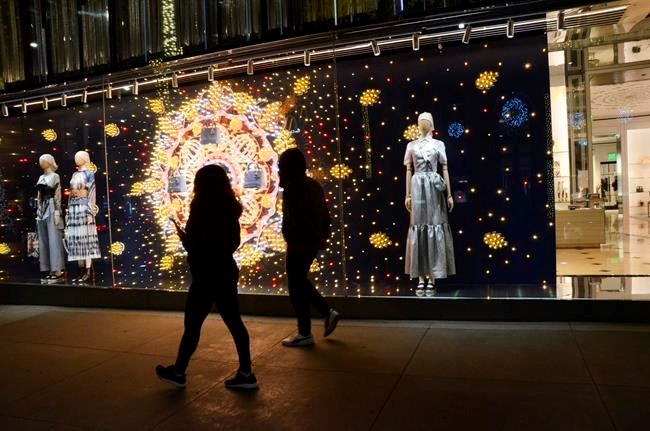SACRAMENTO, Calif. — With coronavirus cases surging at a record pace, California Gov. Gavin Newsom announced a new stay-at-home order Thursday and said if people don't comply the state's hospitals will be overwhelmed with infected patients.
Newsom's latest effort to keep people from gathering with others from outside their households divides the state into five regions and links business closures and travel restrictions to hospital ICU capacity. When a region has fewer than 15% of its ICU beds available, new restrictions are imposed.
Newsom said four regions — all but the San Francisco Bay area — could meet that threshold “within a day or two." A litany of changes would take effect, including closing hair salons, barber shops and movie
Retailers and shopping
The order takes effect Saturday and, once triggered, regions would have 24 hours to implement the rules, which stay in effect at least three weeks. The rules don't apply to public schools with in-person learning.
“The bottom line is if we don’t act now our hospital system will be overwhelmed,” Newsom said during an online news conference from his home, where he has quarantined with his family for the past two weeks after his children were exposed to the virus. “This is the most challenging moment since the beginning of this pandemic.”
The announcement was a gut punch for retailers and restaurants counting on the shopping season to boost a dismal year.
“The loss of revenue many small businesses will experience as a result of this latest shutdown could be catastrophic,” said Allan Zaremberg, California Chamber of Commerce president and CEO.
The new rules are the Newsom administration's latest attempt to control a virus that is spreading at rates that astonished health experts. In the last month, the state has pulled the “emergency brake” by imposing restrictions in 52 of the state's 58 counties, including asking people not to leave the state and implementing an overnight curfew.
The curfew from 10 p.m. to 5 a.m. had little impact, Dr. Mark Ghaly, the state's top public health officer, acknowledged Thursday. He said data shows people have not curtailed trips outside their homes during the period that is only supposed to be for essential trips.
“We of course had hoped and wanted to see more from that already, but we haven't,” he said.
Dr. Jeffrey Klausner, an epidemiologist at the University of California, Los Angeles Fielding School of Public Health, said such a broad shutdown wouldn’t be necessary if the state had better data on where people are contracting the virus.
“We do not have adequate data to know where transmissions are occurring and that reflects a failure of public health,” he said.
Better understanding the data could, for example, show the state if transmissions are occurring at grocery stores, barber shops or restaurants and better target interventions. Klausner likened the current approach to shutting down food production, restaurants and grocery stores because of a salmonella outbreak.
“That’s not the way we traditionally work in public health,” he said.
California imposed the nation's first statewide stay-at-home order in March. It was open-ended and much more aggressive — all but essential businesses were closed.
The order was widely praised by public health experts, but it came with a heavy cost: California lost 2.6 million jobs in March and April, overwhelming the state with claims for unemployment benefits.
Since then, California has gotten 44% of those jobs back in a modest recovery as new cases fell dramatically after large gatherings ceased, and people wore masks and distanced in public.
But by fall people were congregating more as cooler weather drove them inside, where the virus flourishes. A new wave of cases that began in late October has dwarfed anything the state had seen. California is now averaging nearly 15,000 newly reported cases daily.
Unlike in March, when the pandemic was in its infancy and people were more willing to follow rules, the latest mandate will be met by a frustrated population entering its 10th month of restrictions. Some counties have bucked the rules, following cues from state and local elected officials who have criticized the governor for going too far.
Shannon Grove, Republican leader in the state Senate, criticized Newsom on Thursday for continuing “to disrupt life as we know it without releasing the full data behind his decisions.”
“And to be clear, it’s not just about the numbers of COVID-19 cases and hospitalizations he runs through in his almost-daily press conferences, but the data and facts about the toll his shutdown orders are taking on Californians’ mental health, on our children’s education, including the achievement gap, on domestic violence and child abuse rates,” she said.
In San Luis Obispo, hairstylist Amy Lovece said she was angry because “salons are not the problem.”
“I just go between home and work. I don’t go to parties or bars and I just want to keep working,” she said.
California’s virus hospitalizations have nearly quadrupled since mid-October and now stand at 8,240, including 1,890 in intensive care units. California Hospital Association President and CEO Carmela Coyle said 80% of ICU beds in the state are occupied.
“Hospitals are doing everything possible to address this crush of acute care needs but are challenged by a lack of needed critical care nurses, worldwide shortages of personal protective equipment and testing supplies,” Coyle said, adding hospitals support the governor's new restrictions
Newsom acknowledged the difficulty in following the rules. But he urged people to stay vigilant, promising the worst is almost over.
“There is light at the end of the tunnel. We are a few months away form truly seeing real progress with the vaccine,” Newsom said. “We do not anticipate having to do this again but we really all need to step up. We need to meet this moment head on.”
Adam Beam And Kathleen Ronayne, The Associated Press



